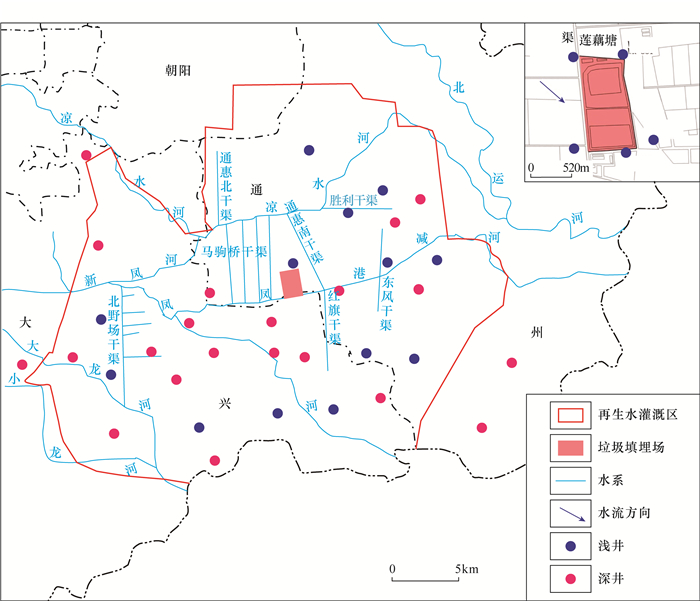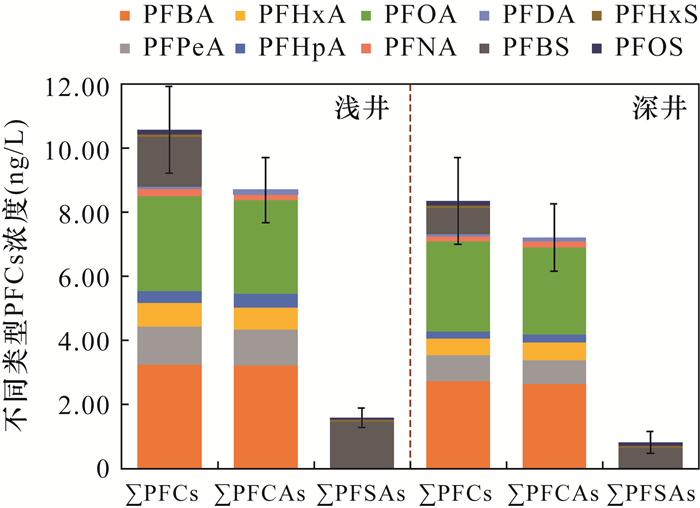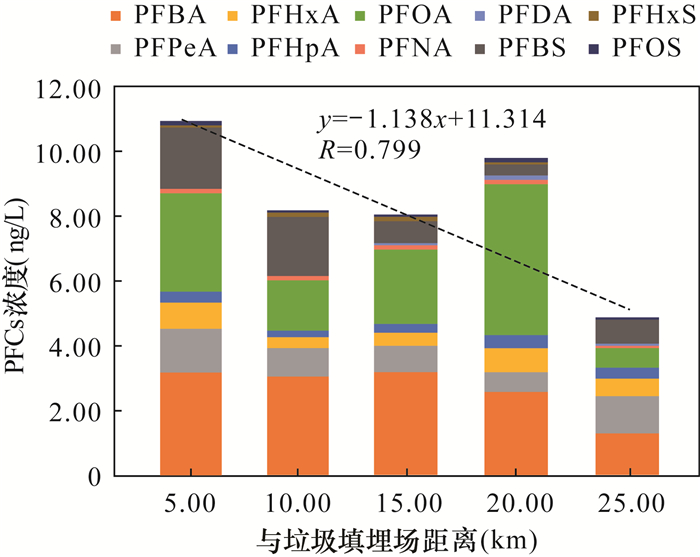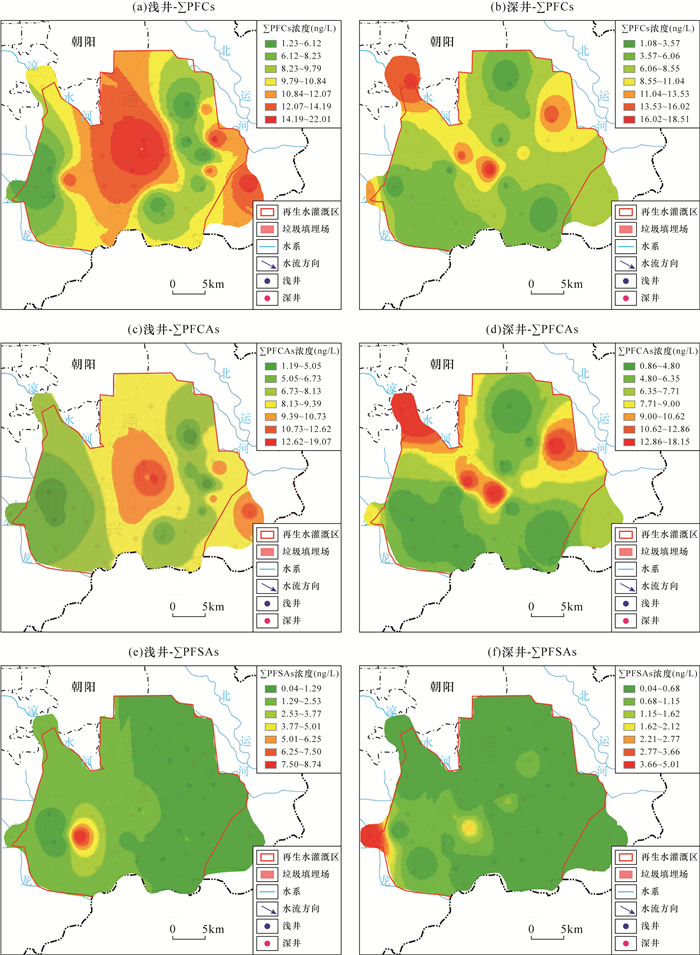The Occurrence, Distribution and Risk Assessment of Typical Perfluorinated Compounds in Groundwater from a Reclaimed Wastewater Irrigation Area in Beijing
-
摘要:
全氟化合物(PFCs)是一种新型持久性有机污染物,因具有持久性、生物蓄积性和高毒性而受到广泛关注。目前关于河流、污水、湖泊等地表水体中PFCs污染状况的研究较多,而地下水PFCs的相关研究相对较少。本文以北京市再生水灌区为例,探讨了典型PFCs化合物在地下水中的含量、分布及其生态风险,并重点关注了灌区内某垃圾填埋场周边地下水PFCs的影响。使用固相萃取-高效液相色谱-串联质谱法分析了2020年5~6月采集自北京市再生水灌区的52个地下水样品,结果表明灌区地下水中不同程度地检出包括全氟羧酸(PFCAs)和全氟磺酸(PFSAs)在内的10种目标PFCs化合物,浓度范围为1.07~24.19ng/L, 其中以全氟正丁酸(PFBA)、全氟正辛酸(PFOA)和全氟丁烷磺酸(PFBS)三类单体的检出浓度最高,平均浓度分别为2.94±2.42ng/L、2.88±3.45ng/L和1.15±2.05ng/L。与来自氟化学工业园的地下水相比,本研究区地下水中∑PFCs浓度明显偏低,这与本研究区观测井多处于农田区域有关。PFCs在浅井(< 50m)与深井(>50m)中的浓度随着井深的增加有明显下降趋势。此外,从全区地下水PFCs的空间分布来看,垃圾填埋场周边的地下水PFCs浓度明显偏高,并随着与垃圾填埋场的距离增加而显著降低,说明垃圾填埋场对周围地下水PFCs的污染具有一定影响。通过计算PFOA、全氟辛基磺酸盐(PFOS)和PFBA的风险商得知,该垃圾填埋场对周边环境尚未构成生态风险,但鉴于地下水PFCs的隐蔽性与持久性,建议继续给予定期监测与评估。
-
关键词:
- 地下水 /
- 全氟化合物(PFCs) /
- 固相萃取 /
- 高效液相色谱-串联质谱法(HPLC-MS/MS) /
- 垃圾填埋场 /
- 生态风险
Abstract:BACKGROUND Perfluorinated compounds (PFCs) have been extensively studied in recent years due to their persistence, bioaccumulation and toxicity. However, most of the studies are concentrated in surface water with high concentration of PFCs in rivers, sewage and lakes, while few studies explore the status of PFCs pollution in groundwater.
OBJECTIVES To investigate the content, distribution and ecological risk of typical PFCs compounds in groundwater in the reclaimed water irrigation area of Beijing.
METHODS 52 groundwater samples were collected from the reclaimed water irrigation area in May to June 2020 and were analyzed by solid phase extraction and high-performance liquid chromatography-tandem mass spectrometry (HPLC-MS/MS).
RESULTS The results showed that 10 target PFCs including perfluorocarboxylic acid (PFCAs) and perfluorosulfonic acid (PFSAs) were detected in groundwater in Beijing, with a concentration of 1.07-24.19ng/L. Among them, the highest detected concentration of perfluorobutanoic acid (PFBA), perfluorooctanoic acid (PFOA), and perfluorobutane sulfonate (PFBS) averaged 2.94ng/L, 2.88ng/L and 1.15ng/L, respectively. The concentration of ∑PFCs in this study was relatively low compared to the groundwater from the fluorochemical industrial park, which was related to the mostly farmland location of the observation wells in the study area. After observing the performance of PFCs in shallow wells (< 50m) and deep wells (>50m), it was found that the concentration of PFCs decreased significantly with increasing well depth. In addition, in view of the spatial distribution of groundwater PFCs in the whole region, the concentration of groundwater PFCs around the landfill was significantly high and decreased with increasing distance from the landfill, indicating that the landfill had a certain contribution to the pollution of surrounding groundwater PFCs.
CONCLUSIONS By calculating the risk quotient of PFOA, perfluorooctane sulfonate (PFOS) and PFBA, the landfill has not posed an ecological risk to the surrounding environment. However, in view of the concealment and persistence of groundwater PFCs, it is recommended to carry out continuous regular monitoring and evaluation.
-

-
表 1 PFCs化合物的MRM参数
Table 1. Multiple reaction monitoring (MRM) parameters for PFCs
PFCs化合物 中文名称 母离子
(m/z)特征子离子
(m/z)去簇电压
DP(V)入口电压
EP(V)碰撞能量
CE(V)碰撞室出口电压
CXP(V)PFBA 全氟正丁酸 213 169 -29 -10 -14 -10 PFPeA 全氟正戊酸 263 219 -30 -10 -13 -15 PFHxA 全氟正己酸 313 269 -35 -10 -13 -18 PFHpA 全氟正庚酸 363 319 -40 -10 -14 -6 PFOA 全氟正辛酸 413 369 -43 -10 -16 -8 PFNA 全氟正壬酸 463 419 -40 -10 -15 -20 PFDA 全氟正癸酸 513 469 -45 -10 -15 -6 PFBS 全氟丁烷磺酸 299 299 -70 -10 -55 -10 PFHxS 全氟己烷磺酸 399 399 -90 -10 -75 -6 PFOS 全氟辛烷磺酸 499 499 -90 -10 -90 -8 表 2 目标物检出限(LOD)、定量限(LOQ)和回收率
Table 2. List of target object detection limit (LOD), quantitative limit (LOQ), and recovery rate
目标物 中文名称 检出限LOD
(ng/L)定量限LOQ
(ng/L)回收率
(%)PFBA 全氟正丁酸 0.08 0.28 82.78 PFPeA 全氟正戊酸 0.08 0.27 79.46 PFHxA 全氟正己酸 0.17 0.58 64.64 PFHpA 全氟正庚酸 0.07 0.23 77.57 PFOA 全氟正辛酸 0.09 0.30 79.12 PFNA 全氟正壬酸 0.13 0.43 67.84 PFDA 全氟正癸酸 0.20 0.68 69.70 PFBS 全氟丁烷磺酸 0.23 0.76 76.70 PFHxS 全氟己烷磺酸 0.14 0.47 77.94 PFOS 全氟辛烷磺酸 0.17 0.57 80.78 表 3 中国不同地区地下水PFCs污染水平
Table 3. PFCs pollution levels in groundwater in different regions of China
PFCs化合物 珠三角
(ng/L)浙江
(ng/L)江苏
(ng/L)山东
(ng/L)北京
(ng/L)辽宁
(ng/L)天津
(ng/L)本文研究
(ng/L)PFBA - 0.16~6.78 ND~2.58 ND~24178 ND~42.9
(7.7)- - 0.22~9.78
(2.94)PFPeA - ND~3.53 ND~1.45 ND~7257 ND~18.7
(3.7)- - ND~4.81
(0.94)PFHxA ND~1.07
(2.04)0.29~3.88 ND~0.94 ND~4950 ND~32.8
(6.8)- (0.17) ND~3.51
(0.60)PFHpA ND~1.49
(0.28)ND~3.92 ND~0.75 ND~
1950ND~11.0
(11.0)-
(0.13)ND~1.53
(0.33)PFOA 0.07~7.76
(1.78)0.51~14.68 0.46~6.29 0.52~111516 ND~6.1
(7.9)4.85~524
(0.81)0.08~14.67
(2.88)PFNA 0.02~1.75
(0.34)ND~1.84 ND~0.42 ND~37.2 ND~20.3
(< MQLs)ND~0.47
(0.06)ND~0.99
(< LOQs)PFDA ND~1.26
(0.22)ND~3.92 ND ND~23 ND ND
(0.06)ND~0.70
(< LOQs)PFBS - ND ND~1.32 ND~42.5 ND~23.2
(6.7)1.19~872 - ND~9.21
(1.15)PFHxS ND~2.46
(0.25)- - ND~4.62 ND~3.4
(0.5)ND~0.68 - ND~0.48
(< LOQs)PFOS ND~41.4
(3.53)ND~0.37 ND ND~37.8 ND~7.4
(2.5)ND~0.73 (1.1) ND~0.22
(< LOQs)参考文献 [34] [35] [35] [36] [2] [37] [38] - 注:“ND”表示低于仪器检出限;“ < MQLs”表示低于方法定量限;括号内数据为平均值;“-”表示未检测。 -
[1] Yasuyuki Z, Jonathan N H, Shigeki M, et al. Progress and perspective of perfluorinated compound risk assessment and management in various countries and institutes[J]. Clean Technologies and Environmental Policy, 2012, 14(1): 9-20. doi: 10.1007/s10098-011-0375-z
[2] 高杰, 李文超, 李广贺, 等. 北京部分地区地下水中全氟化合物的污染水平初探[J]. 生态毒理学报, 2016, 11(2): 355-363. https://www.cnki.com.cn/Article/CJFDTOTAL-STDL201602042.htm
Gao J, Li W C, Li G H, et al. Preliminary investigation on perfluorinated compounds in groundwater in some areas of Beijing, China[J]. Asian Journal of Ecotoxicology, 2016, 11(2): 355-363. https://www.cnki.com.cn/Article/CJFDTOTAL-STDL201602042.htm
[3] Zhu Z Y, Wang T Y, Meng J, et al. Perfluoroalkyl substances in the Daling River with concentrated fluorine industries in China: Seasonal variation, mass flow, and risk assessment[J]. Environmental Science and Pollution Research, 2015, 22(13): 10009-10018. doi: 10.1007/s11356-015-4189-0
[4] United Nations Environment Programme (UNEP). Stockholm convention on persistent organic polutants adoption of amendments to annexes A, B and C[R/OL]. (2009-01-01)[2015-11-26]. http://chm.pops.int/Implementation/NewPOPs/TheNewPOPs/tabid/672/Default.aspx.
[5] 武倩倩, 吴强, 宋帅, 等. 天津市主要河流和土壤中全氟化合物空间分布、来源及风险评价[J]. 环境科学, 2021, 42(8): 3682-3694. https://www.cnki.com.cn/Article/CJFDTOTAL-HJKZ202108013.htm
Wu Q Q, Wu Q, Song S, et al. Distribution, sources, and risk assessment of polyfluoroalkyl substances in main rivers and soils of Tianjin[J]. Environmental Science, 2021, 42(8): 3682-3694. https://www.cnki.com.cn/Article/CJFDTOTAL-HJKZ202108013.htm
[6] Croce L, Coperchini F, Tonacchera M, et al. Effect of long- and short-chain perfluorinated compounds on cultured thyroid cells viability and response to TSH[J]. Journal of Endocrinological Investigation, 2019, 42(11): 1329-1335. doi: 10.1007/s40618-019-01062-1
[7] 张德勇, 许晓路. 全氟辛烷磺酰基化合物(PFOS)类有机污染物在生物体中的污染现状[J]. 生态毒理学报, 2010, 5(5): 639-646. https://www.cnki.com.cn/Article/CJFDTOTAL-STDL201005006.htm
Zhang D Y, Xu X L. Review on perfluorooctanesulphonate (PFOS) contamination of organisms[J]. Asian Journal of Ecotoxicology, 2010, 5(5): 639-646. https://www.cnki.com.cn/Article/CJFDTOTAL-STDL201005006.htm
[8] Yao Y M, Chang S, Sun H W, et al. Neutral and ionic per- and polyfluoroalkyl substances (PFASs) in atmospheric and dry deposition samples over a source region (Tianjin, China)[J]. Environmental Pollution, 2016, 212: 449-456. doi: 10.1016/j.envpol.2016.02.023
[9] Gang P, Qin Z, Xuan L, et al. Distribution of perfluorinated compounds in Lake Taihu (China): Impact to human health and water standards[J]. Science of the Total Environment, 2014, 487: 778-784. doi: 10.1016/j.scitotenv.2013.11.100
[10] Fagbayigbo B O, Opeolu B O, Fatoki O S, et al. Validation and determination of nine PFCS in surface water and sediment samples using UPLC-QTOF-MS[J]. Environmental Monitoring and Assessment, 2018, 190(6): 346-363. doi: 10.1007/s10661-018-6715-2
[11] Dalahmeh S, Tirgani S, Komakech A J, et al. Per- and polyfluoroalkyl substances (PFASs) in water, soil and plants in wetlands and agricultural areas in Kampala, Uganda[J]. Science of the Total Environment, 2018, 631-632: 660-667. doi: 10.1016/j.scitotenv.2018.03.024
[12] Fang S H, Chen X W, Zhao S Y, et al. Trophic magnification and isomer fractionation of perfluoroalkyl substances in the food web of Taihu Lake, China[J]. Environmental Science & Technology, 2014, 48(4): 2173-2182.
[13] 侯沙沙, 王晓晨, 谢琳娜, 等. 氟工厂附近青少年体内全氟化合物(PFASs)暴露特征分析及其与性征发育水平关联性初探[J]. 环境化学, 2020, 39(4): 931-940. https://www.cnki.com.cn/Article/CJFDTOTAL-HJHX202004010.htm
Hou S S, Wang X C, Xie L N, et al. Exposure to perfluoroalkyl and polyfluoroalkyl substances and association with the level of pubertal development of adolescents near a flurochemical plant[J]. Environmental Chemistry, 2020, 39(4): 931-940. https://www.cnki.com.cn/Article/CJFDTOTAL-HJHX202004010.htm
[14] Dai J Y, Li M, Jin Y H, et al. Perfluorooctanesulfonate and periluorooctanoate in red panda and giant panda from China[J]. Environmental Science & Technology, 2006, 40(18): 5647-5652.
[15] Strynar M J, Lindstrom A B, Nakayam S F, et al. Pilot scale application of a method for the analysis of perfluorinated compounds in surface soils[J]. Chemosphere, 2012, 86(3): 252-257. doi: 10.1016/j.chemosphere.2011.09.036
[16] 郑宇, 路国慧, 邵鹏威, 等. 青藏高原东部过渡区水环境中全氟化合物的分布特征[J]. 环境化学, 2020, 39(5): 1192-1201. https://www.cnki.com.cn/Article/CJFDTOTAL-HJHX202005004.htm
Zheng Y, Lu G H, Shao P W, et al. Level and distribution of perfluorinated compounds in snow andwater samples from the transition zone in eastern Qinghai—Xizang[J]. Environmental Chemistry, 2020, 39(5): 1192-1201. https://www.cnki.com.cn/Article/CJFDTOTAL-HJHX202005004.htm
[17] Craig M B, Urs B, Rossana B, et al. Levels and trends of poly- and perfluorinated compounds in the arctic environment[J]. Science of the Total Environment, 2010, 408(15): 2936-2965. doi: 10.1016/j.scitotenv.2010.03.015
[18] Brittany S, Megumi S S, Rosa I S G, et al. Isomers of emerging per- and polyfluoroalkyl substances in water and sediment from the Cape Fear River, North Carolina, USA[J]. Chemosphere, 2020, 262: 128359.
[19] Lutz A, Sachi T, Leo W Y, et al. Distribution of polyfluoroalkyl compounds in water, suspended particulate matter and sediment from Tokyo Bay, Japan[J]. Chemosphere, 2010, 79(3): 226-272.
[20] Chen H, Sun R J, Zhang C, et al. Occurrence, spatial and temporal distributions of perfluoroalkyl substances in wastewater, seawater and sediment from Bohai Sea, China[J]. Environmental Pollution, 2016, 219: 389-398. doi: 10.1016/j.envpol.2016.05.017
[21] Meng J, Wang T Y, Sun S, et al. Tracing perfluoroalkyl substances (PFASs) in soils along the urbanizing coastal area of Bohai and Yellow Seas, China[J]. Environmental Pollution, 2018, 238(7): 404-412.
[22] Zhou Z, Liang Y, Shi Y L, et al. Occurrence and transport of perfluoroalkyl acids (PFAAs): Including short-chain PFAAs in Tangxun Lake, China[J]. Environmental Science & Technology, 2013, 47(16): 9249-9257.
[23] 周珍, 胡宇宁, 史亚利, 等. 武汉地区水环境中全氟化合物污染水平及其分布特征[J]. 生态毒理学报, 2017, 12(3): 425-433. https://www.cnki.com.cn/Article/CJFDTOTAL-STDL201703042.htm
Zhou Z, Hu Y N, Shi Y L, et al. Occurrence and distribution of per-and polufluoroalkyl substances in waste water and surface water samples in Wuhan[J]. Asian Journal of Ecotoxicology, 2017, 12(3): 425-433. https://www.cnki.com.cn/Article/CJFDTOTAL-STDL201703042.htm
[24] Michio M, Keisuke K, Nobuyuki S, et al. Groundwater pollution by perfluorinated surfactants in Tokyo[J]. Environmental Science & Technology, 2009, 43(10): 3480-3486.
[25] Yao Y M, Zhu H K, Li B, et al. Distribution and primary source analysis of per- and poly-fluoroalkyl substances with different chain lengths in surface and groundwater in two cities, North China[J]. Ecotoxicology and Environmental Safety, 2014, 108: 318-328. doi: 10.1016/j.ecoenv.2014.07.021
[26] Zhu X B, Jin L, Yang J P, et al. Perfluoroalkyl acids in the water cycle from a freshwater river basin to coastal waters in eastern China[J]. Chemosphere, 2017, 168: 390-398. doi: 10.1016/j.chemosphere.2016.10.088
[27] Kerstin W, Robin V, Urs B, et al. Early life exposure to per- and polyfluoroalkyl substances (PFASs): A critical review[J]. Emerging Contaminants, 2017, 3(2): 55-68. doi: 10.1016/j.emcon.2017.05.001
[28] Li M L, Yi S J, Chen P Y, et al. Thyroid endocrine disruption effects of perfluoroalkyl phosphinic acids on zebrafish at early development[J]. Science of the Total Environment, 2019, 676: 290-297. doi: 10.1016/j.scitotenv.2019.04.177
[29] Xiao Y, Gu X M, Yin S Y, et al. Investigation of geochemical characteristics and controlling processes of groundwater in a typical long-term reclaimed water usearea[J]. Water, 2017, 9(10): 800. doi: 10.3390/w9100800
[30] 马闯, 杨军, 雷梅, 等. 北京市再生水灌溉对地下水的重金属污染风险[J]. 地理研究, 2012, 31(12): 2250-2258. https://www.cnki.com.cn/Article/CJFDTOTAL-DLYJ201212013.htm
Ma C, Yang J, Lei M, et al. Assessing the effect of reclaimed water irrigation on groundwater pollution of heavy metals in Beijing[J]. Geographical Research, 2012, 31(12): 2250-2258. https://www.cnki.com.cn/Article/CJFDTOTAL-DLYJ201212013.htm
[31] 朴海涛, 陈舒, 焦杏春, 等. 大运河丰水期水体中全氟化合物的分布[J]. 中国环境科学, 2016, 36(10): 3040-3047. doi: 10.3969/j.issn.1000-6923.2016.10.029
Piao H T, Shu C, Jiao X C, et al. Geographical distribution of perfluorinated compounds in waters along the Grand Canal during wet season[J]. Chinese Environmental Science, 2016, 36(10): 3040-3047. doi: 10.3969/j.issn.1000-6923.2016.10.029
[32] So M K, Miyake Y, Yeung W Y, et al. Perfluorinated compounds in the Pearl River and Yangtze River of China[J]. Chemosphere, 2007, 68(11): 2085-2095. doi: 10.1016/j.chemosphere.2007.02.008
[33] Sachi T, Kurunthachalam K, Leo W Y Y, et al. Analysis of trifluoroacetic acid and other short-chain perfluorinated acids (C2-C4) in precipitation by liquid chromatography-tandem mass spectrometry: Comparison to patterns of long-chain perfluorinated acids (C5-C18)[J]. Analytica Chimica Acta, 2008, 619(2): 221-230. doi: 10.1016/j.aca.2008.04.064
[34] 刘庆. 珠三角地区典型污染源及地下水中全氟化合物的分布特征研究[D]. 兰州: 兰州交通大学, 2014.
Liu Q. Occurrence antidistribution of perfluorinated compounds in typical pollution sources and groundwater in the Pearl River Delta[D]. Lanzhou: Lanzhou Jiaotong University, 2014.
[35] Chen S, Jiao X C, Gai N, et al. Perfluorinated compounds in soil, surface water, and groundwater from rural areas in eastern China[J]. Environmental Pollution, 2016, 211: 124-131. doi: 10.1016/j.envpol.2015.12.024
[36] Liu Z Y, Lu Y L, Wang T Y, et al. Risk assessment and source identification of perfluoroalkyl acids in surface and ground water: Spatial distribution around a mega-fluorochemical industrial park, China[J]. Environment International, 2016, 91: 69-77. doi: 10.1016/j.envint.2016.02.020
[37] Bao J, Liu W, Liu L, et al. Perfluorinated compounds in the environment and the blood of residents living near fluorochemical plants in Fuxin, China[J]. Environmental Science & Technology, 2011, 45(19): 8075-8080.
[38] 王晓伟. 北方某典型活动区地下水中PBDEs/PFASs的污染特征[J]. 环境科学与技术, 2017, 40(7): 79-85. https://www.cnki.com.cn/Article/CJFDTOTAL-FJKS201707013.htm
Wang X W. PBDEs/PFASs residues in groundwater of a typical agricultural region in North China[J]. Environmental Science & Technology, 2017, 40(7): 79-85. https://www.cnki.com.cn/Article/CJFDTOTAL-FJKS201707013.htm
[39] Rodrigo A N, Deborah B O N, Ekhine B, et al. Sulflura-mid use in Brazilian agriculture: A source of per- and polyfluoroalkyl substances (PFASs) to the environment[J]. Environmental Pollution, 2018, 242(Part B): 1436-1443.
[40] Huang T M, Ma B Q, Pang Z H, et al. How does precipitation recharge groundwater in loess aquifers?Evidence from multiple environmental tracers[J]. Journal of Hydrology, 2020, 583(C): 124532.
[41] Xiao F, Matt F S, Thomas R H, et al. Perfluorooctane sulfonate (PFOS) and perfluorooctanoate (PFOA) in soils and groundwater of a U.S. metropolitan area: Migration and implications for human exposure[J]. Water Research, 2015, 72: 64-74. doi: 10.1016/j.watres.2014.09.052
[42] Jan B, Lutz A, Renate S, et al. Polyfluoroalkyl compounds in landfill leachates[J]. Environment Pollution, 2010, 158(5): 1467-1471. doi: 10.1016/j.envpol.2009.12.031
[43] Yan H, Cousins I T, Zhang C J, et al. Perfluoroalkyl acids in municipal landfill leachates from China: Occurrence, fate during leachate treatment and potential impact on groundwater[J]. Science of the Total Environment, 2015, 524: 23-31.
[44] 杜国勇, 蒋小萍, 卓丽, 等. 长江流域重庆段水体中全氟化合物的污染特征及风险评价[J]. 生态环境学报, 2019, 28(11): 2266-2272. https://www.cnki.com.cn/Article/CJFDTOTAL-TRYJ201911016.htm
Du G Y, Jiang X P, Zhuo L, et al. Distribution characteristics and risk assessment of perfluorinated compounds in surface water from Chongqing Section of the Yangtze River[J]. Ecology and Environmental Sciences, 2019, 28(11): 2266-2272. https://www.cnki.com.cn/Article/CJFDTOTAL-TRYJ201911016.htm
[45] 乔肖翠, 赵兴茹, 郭睿, 等. 典型岩溶区水环境中全氟化合物分布特征及风险评价[J]. 环境科学研究, 2019, 32(12): 2148-2156. https://www.cnki.com.cn/Article/CJFDTOTAL-HJKX201912026.htm
Qiao X C, Zhao X R, Guo R, et al. Distribution characteristics and risk assessment of per-and polyfluoroalkyl substances in water environment in typical karst region[J]. Research of Environmental Sciences, 2019, 32(12): 2148-2156. https://www.cnki.com.cn/Article/CJFDTOTAL-HJKX201912026.htm
-




 下载:
下载:


